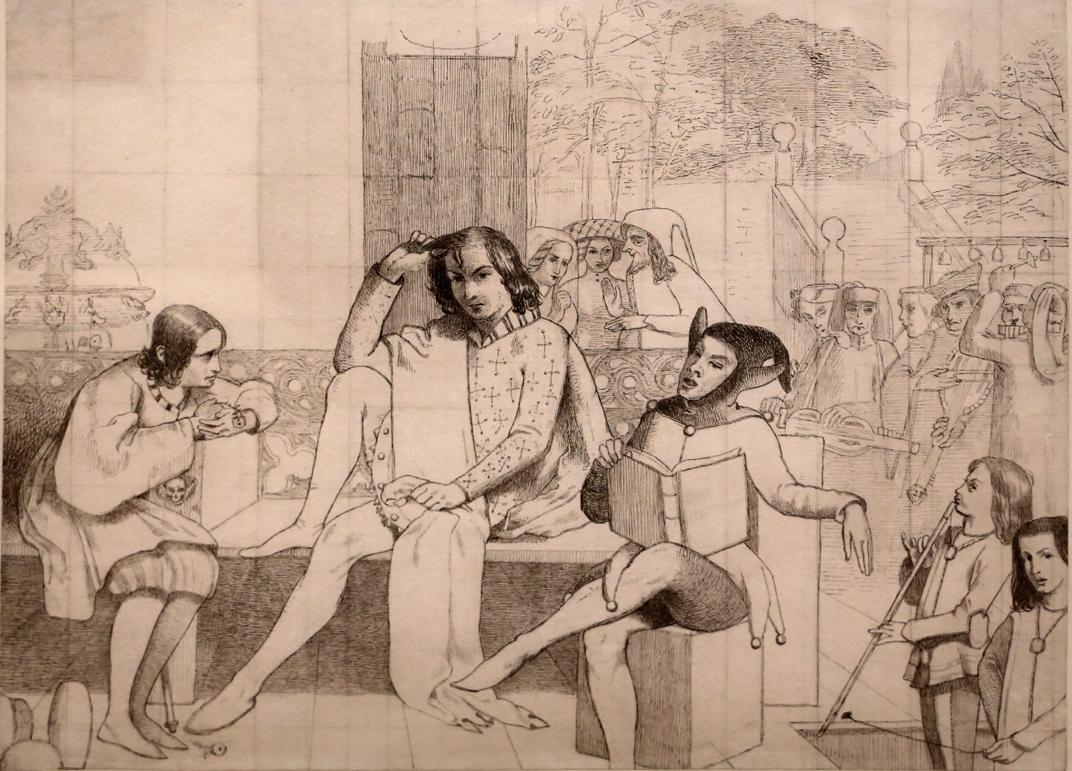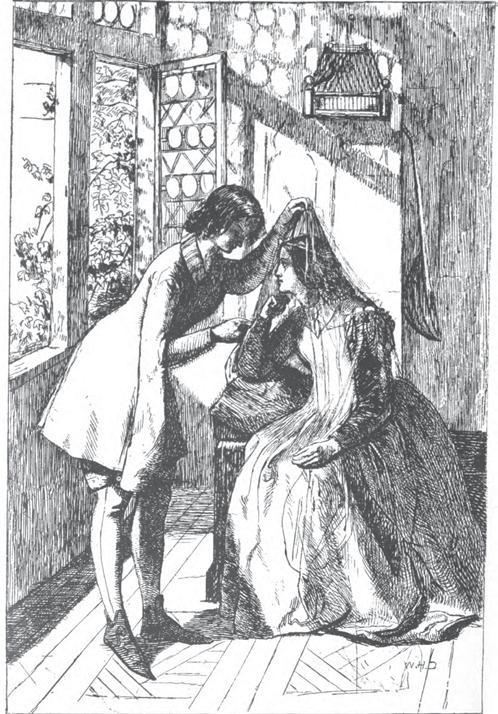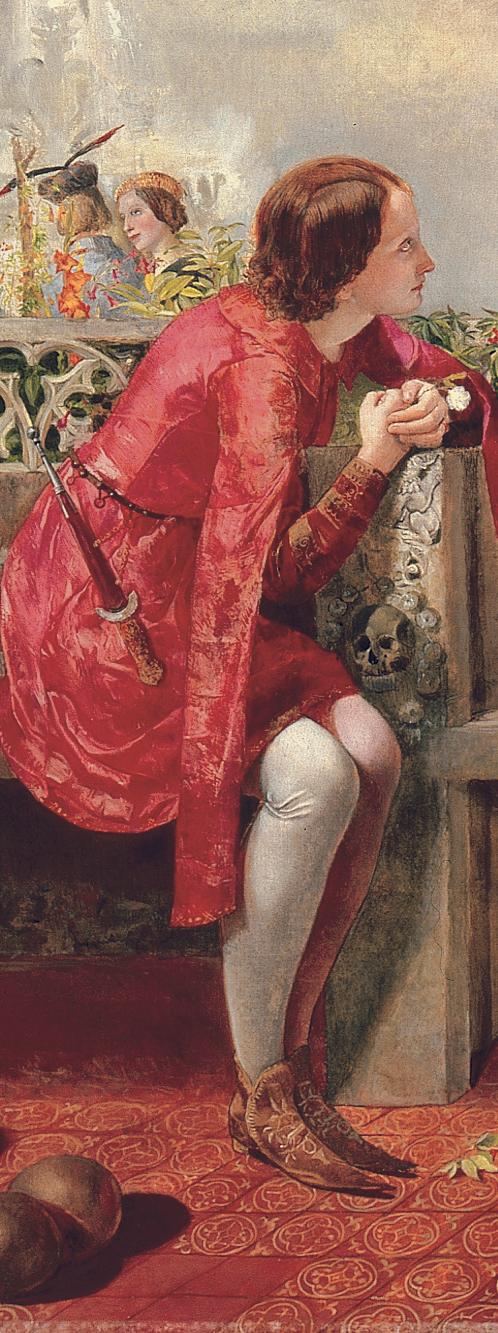





Opposite: D. G. Rossetti, Sketch of Elizabeth Siddal at the Easel, (approximately actual size), c. 1852
Frontispiece (p. 2): D. G. Rossetti, Portrait of Elizabeth Siddal, 1854
143
Acknowledgements 147
Notes 148
Works Cited 151
List of illustrations 153
Index 158

Opposite: D. G. Rossetti, Portrait head of Elizabeth Siddal (approximately actual size), date unknown
In biography you have your little handful of facts, little bits of a puzzle, and you sit and think, and fit ’em together this way and that, and get up and throw ’em down and say damn, and go out for a walk.
Robert Louis Stevenson, 18 June 1893
The first, and indeed only, obituary of Elizabeth Siddal was published in the Sheffield and Rotherham Independent on 18 February 1862. 1 Written by William Ibbitt, artist and silversmith, who knew Siddal during her visit to the city in 1857, it was based on her own account of her life. This made no mention of modelling for the painters of the Pre-Raphaelite Brotherhood, but told the story of a dressmaker with ambitions to become an artist, who had secured the patronage of John Ruskin, and exhibited with the PRB.
Over 20 years later, when Pre-Raphaelite histories began to appear, Siddal was cited only as the beautiful model and muse, romantically discovered working in a bonnet shop, who had become the sickly, tragic wife of Dante Gabriel Rossetti. In the first biographical account of Siddal, published in 1903, Rossetti’s brother William listed 24 artworks and reconstructed 13 poems from drafts. But clearly ignorant of the Sheffield obituary, he concluded that, despite the feebleness of both pictures and verses, she was ‘a woman of unusual capacities, worthy of being espoused to a painter and poet’.2
Thereafter, more or less imaginative iterations of Siddal’s life story cast her as a dove, a betrayed beloved, a doomed victim, a drug addict, a supermodel and a Pre-Raphaelite icon. The present book ascertains what can be factually known and inferred about Elizabeth Siddal’s life from contemporary sources. Sadly, it can’t aspire to the account she herself would have written, but it does aim to dispose of myths and misinterpretations.




LET’S BEGIN AT THE BEGINNING, to trace out what is known of Elizabeth Siddal’s life as best we can. The sources are fragmentary but, like a jigsaw puzzle with missing pieces, when assembled may yield a narrative picture.
We can start with her birth, in July 1829 in the Holborn area of London, one of eight children born to Elizabeth Eleanor, formerly Evans, wife of Charles Siddall, maker and retailer of cutlery and bladed tools. He was from Sheffield, centre of skilled craftsmen producing sharp ‘edge tools’: knives, scissors, razors, chisels.The family moved to different homes and by 1849 were living on the Old Kent Road in Southwark, with a shop on the street and rooms above. The district was a thriving mix of lower-middle and working-class households. One childhood memory recounted by Elizabeth was of a neighbour who lifted her over the muddy roadway—and was later hanged for murdering his lover.
Maybe that grew in the retelling, although the dates fit, and the remembrance fits with her liking for melodramatic and macabre tales.
Opposite: D. G. Rossetti, Study for Delia, 1853. Illustration to a Latin poem in which the poet’s beloved dreamily imagines his return
In Victorian terms, Charles Siddall was ‘in trade’ and therefore not a ‘gentleman’. But the family was not impoverished. There were tales of the Siddalls, in the Derbyshire village of Hope, having once been gentry, with armorial bearings. The sons Charles, James and Henry were trained to carry on the cutlery business; the daughters’ occupation was entered in the national census as ‘dressmaker’, meaning they too worked from home, making and remaking women’s garments as fashions evolved. The census lists no live-in servants, but it is likely that daily cleaners and washerwomen were employed. Mrs Siddall’s sister Lucy and her husband William Day kept a grocery shop in Islington, an area of middle-class villas. When in 1855 Gabriel Rossetti visited the Siddall home in Southwark, he was relieved
to report that his sweetheart’s ‘native crib’ was ‘comfortable’.1 Her family was not working class and later acquaintances noted that she spoke without grammatical errors or a local accent.
She had discovered the poetry of Tennyson by reading some verses in paper used to wrap groceries.2 Like most girls of her era, she will have been mainly homeschooled in literacy, numeracy, scripture, sewing, and perhaps ‘ladylike’ manners. No more personal details of Elizabeth’s youth are known. According to William Rossetti, two sisters—Clara and Lydia—and two brothers—James and Harry—were still around in 1900, 3 but noone sought them to ask about their sister’s early life.
Her first ‘appearance’ in the art world was in the last weeks of 1849, when she posed for the artist Walter Deverell. She was dressed in costume as the character of Viola in Shakespeare’s Twelfth Night, in disguise as the boy Cesario.
Ignore for the moment the familiar but uncorroborated tale of Walter discovering Lizzie working in a milliner’s shop. It dates from the 1880s when all the witnesses were dead. In 1857, Lizzie gave a different account to friends in Sheffield. In this, she said she had become acquainted with the Deverell family as a dressmaker, and had then ‘shown some outlines, designs of her own leisure hours’4 to Walter’s father, who was principal of the government-funded School of Design in London. Through his encouragement, she met Walter and members of the PreRaphaelite Brotherhood, including Rossetti and Holman Hunt. This narrative is itself untrustworthy—the details given or retained were doubtless incomplete—but it includes the vital detail of Lizzie’s artistic endeavours (her own drawings) before she met the PRBs; these aspirations shaped later events. It glides over another detail, which is her initiative in approaching Mr Deverell, presumably to ask his opinion—a rather bold step for a young woman, but explicable if she was applying to enrol in
a daytime class at the School of Design. One can’t immediately imagine what her ‘own designs’ depicted. Perhaps they illustrated literary or biblical texts, like some of her later works. Maybe they were fashion sketches like those printed in the new weekly magazines. My best guess is that they were imaginative images, prompted by poetic sources, in the manner of the illustrated anthologies that surged into popularity in the late 1840s, with elaborate steel engravings and decorative devices. One possibility is that they were inspired by Tennyson’s popular poems like ‘The Lady of Shalott’, which was the subject of her first PreRaphaelite drawing.


One likely response from Mr Deverell would have been encouragement to study in the School’s female classes. Aimed at those needing to earn, these classes in draughtsmanship and basic design were appropriate to those working in the fashion trades, or to women employed colouring up engraved prints.
It is not known that Siddal took any such class. She seems

to have had higher aspirations towards fine art, and possibly saw more potential in the studios, agreeing or even offering to pose for Walter. He had been over-ambitious in creating a multifigure scene from Twelfth Night, destined for the next summer exhibition at the Royal Academy. The modelling sessions took place in December 1849, either in the School of Design, where Walter taught alongside his father, or in the Deverell home. Lizzie took at least two poses—one profile pose listening as Count Orsino laments his love for the Lady Olivia, and one raising Olivia’s veil, as Cesario woos as Orsino’s messenger. The first was painted on to the large canvas, the second transformed into an etching for the PRB magazine The Germ. The first gives an accurate rendering of Siddal’s pale, translucent skin and bright auburn hair (pictorially cut short); the second, in the words of William Rossetti ‘does not give much idea, but is not unlike her in a way…’
What’s remarkable is that in both images Cesario wears male attire, dressed as a page boy with tunic over tights, in garments borrowed—perhaps literally—from a stage-costume box. Such boyish outfits were worn by young ingénue performers with shapely legs to please theatre audiences. Offstage, women always wore long skirts. Siddal’s willingness to pose wearing tights seems eloquent of her liking for studio life. She evidently then agreed or volunteered to pose for Deverell’s friends.
Over the winter of 1849-50, as Holman Hunt was painting a crowded scene of a native British family rescuing a Christian priest from Druid attack, he had ‘bothers with models’, according to William Rossetti’s record of PRB activities. With Lizzie’s availability, the figure of an old woman was changed to that of a girl, clad in hessian, tending to the wounded priest. Later, Hunt asserted that because the figure was conceived as having the ‘rough character’ of an ancient Briton, his image did not convey

W. Holman Hunt, detail from British Family Sheltering a Christian Priest, 1850. Siddal modelled an ‘ancient Briton’ rescuing a priest from Druids in the Roman era
Siddal’s ‘grace or refinement’. She looks recognisable, however. Siddal was evidently a useful rather than a glamorous model.
If she went to see her likenesses at the summer exhibitions,5 she may have been with her father or mother. It was customary for young women to be accompanied in public. More likely she went with Deverell. At the RA she will have seen Millais’s Christ in the House of his Parents, which provoked a hostile howl from Charles Dickens for its ugly depiction of the Holy Family.

Lizzie told her Sheffield friend Mr Ibbitt that Walter had proposed marriage. Not implausible: he was good-looking and high-spirited, sharing Lizzie’s taste for the theatre as well as art and literature. At 20, she was the age to seek a husband. But it is improbable, because Walter, aged 23, was not in a position to propose. He had yet to succeed as a painter, he was deputising for his father at the School of Design, and his health was poor. Lizzie’s hope of a partnership was surely wishful thinking.
Hardly any direct testimony in diaries or letters by Elizabeth Siddal survives, so all previous accounts of Siddal’s life— including my own—draw on the words of contemporaries and later commentators. They are not misleading, but naturally convey their authors’ perspectives. Life writers therefore deploy creative imagination akin to fictional narrative as an alternative route into biography, ideally allied to historical rigour that keeps strictly to known facts. My aim here is to chronicle known events as they unfolded, with as little hindsight as possible.
Modelling, especially in the studios of unmarried young men, was not a respectable practice. Siddal’s willingness to pose bespeaks disrespect for convention as well as a liking for art. No recollections mention a chaperone. In August 1850 she was again in Hunt’s studio, modelling for his next painting, a scene from Two Gentlemen of Verona. This was a challenging pose, kneeling as Sylvia while Valentine intervenes to prevent Proteus’s sexual